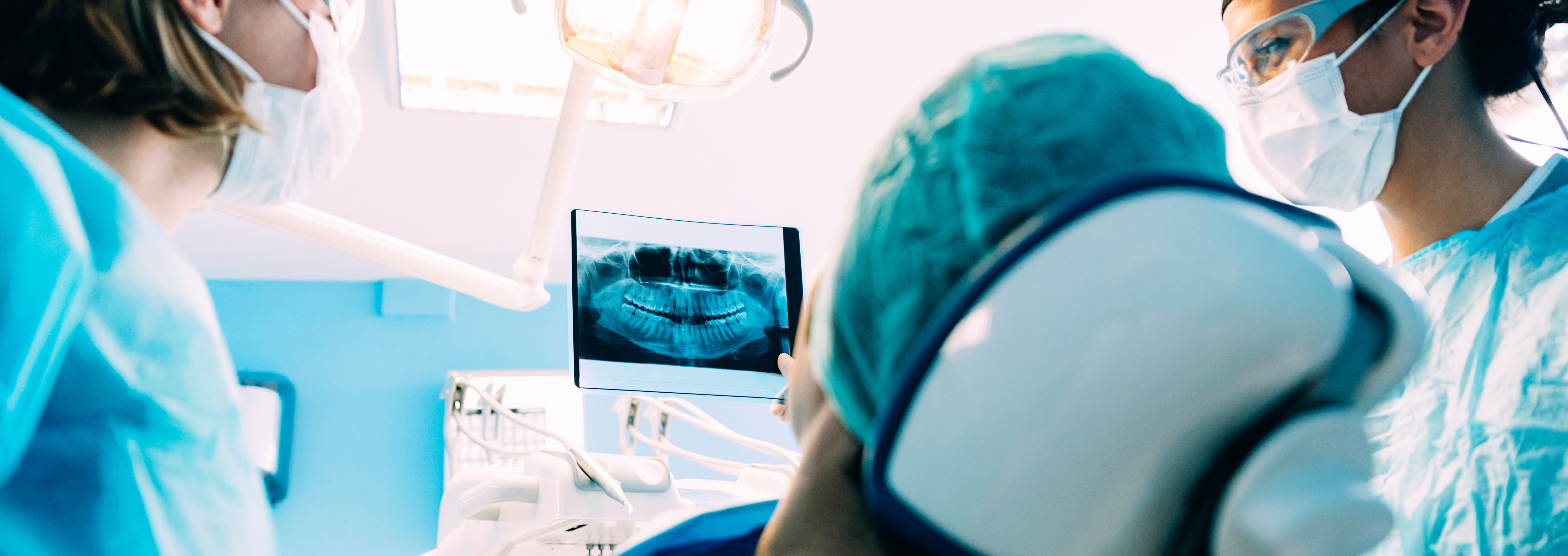
Oral and Maxillofacial Surgery
Dentoalveolar surgery
Dentoalveolar surgery involves surgical procedures in the area of the oral cavity, including the teeth and the periodontium.
-
The most frequently impacted (unerupted or partially erupted tooth) and displaced teeth are the wisdom teeth. These are generally not removed until they have caused pain or infection. However, the indication for extraction should be prophylactic. This can ensure a lasting therapeutic success and prevent complications. If the displaced teeth are left, inflammatory eruption problems (dentitio difficilis), cysts, periodontitis and cavities on the tooth in front of it can develop.
The best time to remove impacted teeth is in adolescence because root growth is not yet completely finished. As you get older, ankylosis (adhesion of the tooth with the surrounding bone) can occur, which complicates the extraction of the tooth.
-
Another aspect of dentoalveolar surgery is autogenous tooth transplantation, through which damaged teeth can be restored. Transplantation has a high probability of success as long as the indication and the timing of the tooth transplantation are chosen correctly. For example, molars (large teeth in the rear jaw area) that are prematurely damaged can be replaced by wisdom tooth germs. Transplantation has the best prognosis when root growth of the tooth to be transplanted is only about two-thirds complete at the time of transplantation. Tooth transplants are no longer as successful when the root growth has already been fully completed. In these cases, an implant should be used.
-
The main indication for apicoectomies is the apical inflammation of teeth, which cannot be treated with a conventional root canal. The periapical pathological tissue and the apical root section are removed. The objective of this procedure is to achieve a bacteria-resistant canal closure at the resection point. Depending on the sufficiency of the existing root filling, retrograde filling can be performed after an apicoectomy. For many years, we have been using a polyketone-based filling material (Diaket), which has very good tissue compatibility, volume constancy in the presence of moisture, and good seal tightness as well as an antibacterial effect.
In the anterior area, above all, apicoectomies can be performed with a high probability of success. But it is also possible to perform this procedure on the multi-rooted posterior teeth. However, this surgical procedure is more complex, and success is more difficult to predict in each case. It may be necessary in this case as well to check at an early stage if a tooth implant is a viable alternative treatment.
-
A cyst is defined as a pathological cavity filled with fluid. They are located in bones or in soft tissue. Small cysts are removed in whole by cystectomy and then examined histopathologically. When treating larger cysts, a cystostomy can be performed before the cystectomy. In this procedure, a wall of the cyst is removed, and the resulting cavity is made into a side bay of the oral cavity, which slowly shrinks.
-
For some years now, the insertion of skeletal (anchored in the bone) orthodontic anchoring elements has also been part of the range of surgeries at the Polyclinic for Oral and Maxillofacial Surgery. These are temporary anchors (screws or plates) that are easy to insert in the posterior region and are used for orthodontic tooth movements. They save the patients from having to wear complex extraoral apparatuses, such as headgear. Insertion and removal of the anchoring elements can be easily performed as an outpatient procedure with local anaesthesia. Planning is coordinated with the Polyclinic for Orthodontics at the hospital or with the referring orthodontics practice.
-
Dentoalveolar traumatology plays an important role in the Polyclinic for Oral and Maxillofacial Surgery. If teeth or bone fragments are completely or partially torn from their anchoring, these can be repositioned (reinserted) and splinted under local anaesthesia. An archwire-plastic splint is attached to the affected teeth and adjacent teeth by means of an acid etching technique without traumatising the periodontium. Further treatment is carried out in the hospital in interdisciplinary cooperation with the Polyclinic for Restorative Dentistry and Periodontology.
-
An above-average share of the patients that visit our clinic are high-risk patients. These are patients who you can assume, based on their general medical history, have an increased risk of complications. This includes, for example, patients with serious heart diseases, for whom necessary treatments are carried out under anaesthesiological control (stand-by) after determination of indications and preliminary internal examinations. Although these procedures are generally carried out without any life-threatening incidents, we can guarantee that patients are in very safe hands thanks to the presence of emergency-trained doctors.
Many patients with coagulation disorders also come to our polyclinic for surgical treatment. In these cases, treatment is carried out depending on the type of coagulation disorder in cooperation with the patient’s general practitioner or internist, or with the coagulation outpatient clinic of the hospital’s haematology department.








